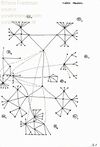User:Claxhanson/References: Difference between revisions
Claxhanson (talk | contribs) |
Claxhanson (talk | contribs) |
||
| Line 2: | Line 2: | ||
- Alejandro Cartagena | - Alejandro Cartagena | ||
Epilogue | |||
Urban infrastructure is a gear of political power. Its aim is to conquer the territory of the city and hold dominion over certain city relationships. Public space is more than just a polygon delineated by coordinates, it is a factory of social realities. There would be nothing problematic about this power if it weren’t exclusive. Those who build the city exercise a regulatory power over our mindset and our everyday experience. The rhythms that regulate our hours, "our place" in society and the type of roads we take on our daily commute are manifestations of this control. | Urban infrastructure is a gear of political power. Its aim is to conquer the territory of the city and hold dominion over certain city relationships. Public space is more than just a polygon delineated by coordinates, it is a factory of social realities. There would be nothing problematic about this power if it weren’t exclusive. Those who build the city exercise a regulatory power over our mindset and our everyday experience. The rhythms that regulate our hours, "our place" in society and the type of roads we take on our daily commute are manifestations of this control. | ||
Revision as of 15:03, 29 September 2020
A guide to infrastructure and corruption
- Alejandro Cartagena
Epilogue
Urban infrastructure is a gear of political power. Its aim is to conquer the territory of the city and hold dominion over certain city relationships. Public space is more than just a polygon delineated by coordinates, it is a factory of social realities. There would be nothing problematic about this power if it weren’t exclusive. Those who build the city exercise a regulatory power over our mindset and our everyday experience. The rhythms that regulate our hours, "our place" in society and the type of roads we take on our daily commute are manifestations of this control.
Behind urban infrastructure are countless relationships of power as well as a certain repertoire of knowledge, speeches, fashion and images that tend to justify plunder or destruction. Therefore the overpass and throughway turn out to be the material outcome of coalitions between a wide range of ideas, beliefs and relationships, which constitute its true power: they represent the city on the continual path of progress.
This is how planners, partners and administrators end up making public spaces an ideological issue. Progress is no longer a visual representation but a political reality that influences what should or should not take up space in a city. This is an anarchical control - not anarchist - as its order depends on a battle with no rules, in which the winners are those who manage to impose their will and have sufficient strength to repel any resistance. Ultimately, this control wil implode because it systemically denies life and memory their rightful place.
Consequently, those who build the city are the fortunate winners in a cacophonic bidding war. The guidelines are dictated by construction companies that will raise the avenue in spite of public opposition. The end results are cities that are ideal for doing business but not for living.
The affected parties have no choice but to resign themselves to the inevitable or simply to move out. Progress is hard to dispute although it erases all reference to proper living; the products are dreg-cities, burrs stuck to the production line.
The Funambulist magazine
Weaponized infrastructures
“A construction project is worth a battalion” said French General and colonial administrator Hubert Lyautey (1854-1934), a key strategist of French colonialism in Vietnam, Madagascar, and Morocco.
Insurgent architecture
Architecture and colonialism
The two editorial arguments of this issue are simple: colonialism is not an era, it is a system of military/police, legal, administrative, social, and cultural system of domination; and, architecture is not (only) an aesthetic vessel, it is an apparatus organizing and hierarchizing bodies in space.
AFROFUTURIST POLITICS: LESS POWER, MORE COMMITMENT - Mawena Yehoussi
De-platform-ization, Ethics and Alternative Social Media :
"Against the totality of networks and corporately owned social media, what are workable strategies and ethical approaches that allow for alternative ways for our social life to emerge?"
http://display.cz/en/events/de-platformization-ethics-and-alternative-social-media
Here and Now? Explorations in Urgent Publishing
Key notions of relations, trust, and remediation : https://networkcultures.org/makingpublic/2020/05/20/here-and-now-explorations-in-urgent-publishing/
UPSIDE DOWN, INSIDE OUT: A RELATIONAL APPROACH TO CONTENT STRUCTURE
PARASITIZING THE AFTERLIFE: POSITIONING THROUGH REMEDIATION
Yona Friedman
Utopies réalisables
L’architecture de survie (une philosophie de la pauvreté)
"Who has the right to decide, and the power of agency over architecture?
How to ensure this right to those to whom it belongs?
How to do it in a world that is heading towards increasing poverty?
How to survive in such a world?"

Year: 1978
The commission for designing David d’Angers High School enabled Friedman to verify his ideas for self-planning by a group of future users.
In different stages and by a set of rules the users decided on the lay-out of the building.
The complete diagram
Themes:
- Self-planning
- principles of Mobile Architecture
- Urban networks
